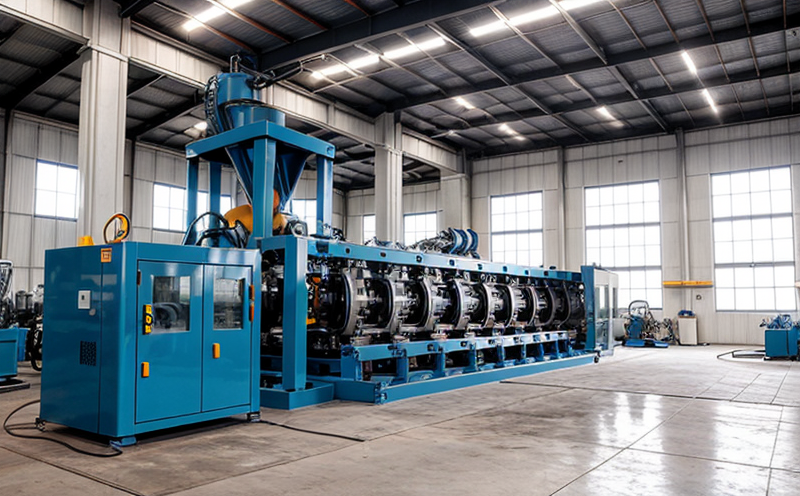ASTM E2658 Machine Tools Energy Performance Testing
The ASTM E2658 standard is a pivotal tool in the evaluation of machine tools' energy efficiency. This testing ensures that manufacturing equipment operates within optimal parameters, minimizing unnecessary power consumption and reducing costs for industrial manufacturers. The test procedure outlined in ASTM E2658 aims to provide accurate measurements of energy performance by simulating real-world operating conditions.
Machine tools are essential components in the industrial sector, responsible for precision machining processes that drive production efficiency. With increasing focus on sustainability and cost-effectiveness, understanding the energy consumption of these machines is crucial. ASTM E2658 provides a standardized method to assess this performance, ensuring that manufacturers can make informed decisions about their equipment.
The testing process involves several steps: setting up the machine tool in its operational environment, configuring it according to specific test protocols, and measuring energy consumption under defined conditions. This approach ensures consistency across different tests and facilities, thereby enhancing comparability of results. Compliance with ASTM E2658 not only aids in regulatory adherence but also enhances a company’s reputation for environmental responsibility.
Implementing ASTM E2658 can lead to significant benefits for industrial manufacturers. By identifying inefficiencies early on, businesses can optimize their machinery and processes. This optimization translates into reduced operational costs, enhanced productivity, and a more sustainable manufacturing footprint. For quality managers and compliance officers, adhering to this standard ensures that the organization meets industry benchmarks.
R&D engineers benefit from ASTM E2658 by having a clear framework for developing and refining energy-efficient machine tools. The testing process allows them to identify areas where improvements can be made, leading to innovations in design and functionality. Procurement professionals find value in this standard as it helps in evaluating suppliers based on their compliance with industry standards, ensuring the acquisition of high-quality equipment.
| Standard Number | Description |
|---|---|
| ASTM E2658 | Standard Practice for Measuring Energy Consumption of Machine Tools During Production Operations |
The standard is widely recognized and implemented in industries such as automotive, aerospace, and electronics manufacturing. By adopting ASTM E2658, these sectors can ensure that their machinery operates efficiently, contributing to overall operational excellence.
Why It Matters
The importance of energy efficiency in machine tools cannot be overstated in today’s industrial landscape. As global concerns about climate change and resource sustainability grow, the focus on reducing energy consumption is more critical than ever. Machine tools consume a significant amount of power during production operations, making their energy performance a key factor in overall plant efficiency.
Compliance with ASTM E2658 helps manufacturers meet regulatory requirements and industry standards. This compliance not only ensures that the equipment meets specified energy consumption limits but also contributes to reducing carbon footprints and operational costs. For quality managers, this standard provides a reliable method for monitoring performance over time, allowing for timely interventions if necessary.
From an economic perspective, optimizing machine tool efficiency through ASTM E2658 can lead to substantial savings. By identifying and addressing inefficiencies early in the production process, manufacturers can reduce energy waste significantly. This reduction translates into lower utility bills and improved profitability. Compliance with this standard also enhances a company’s reputation for environmental responsibility, which is increasingly important for attracting customers and investors.
Moreover, ASTM E2658 supports continuous improvement initiatives within manufacturing plants. By regularly testing machine tools according to this standard, manufacturers can identify trends in energy consumption and make informed decisions about maintenance and upgrades. This proactive approach ensures that the machinery remains at peak performance levels, contributing to long-term sustainability.
Applied Standards
| Standard Number | Description |
|---|---|
| ASTM E2658 | Standard Practice for Measuring Energy Consumption of Machine Tools During Production Operations |
Quality and Reliability Assurance
Ensuring the quality and reliability of machine tools is crucial in any manufacturing process. ASTM E2658 plays a vital role in this regard by providing a robust framework for evaluating energy performance. The testing procedure outlined in this standard ensures that machine tools operate within specified parameters, thereby enhancing overall product quality.
The initial setup and configuration of the machine tool are critical steps in conducting an ASTM E2658 test. This involves calibrating instruments, ensuring proper alignment, and verifying that all components function as intended. Once these preliminary checks are complete, the actual testing can begin under controlled conditions. This controlled environment simulates real-world operating scenarios, providing accurate data on energy consumption.
During the test, various parameters need to be closely monitored, including voltage levels, current draw, and operational time. These metrics are recorded at regular intervals throughout the test duration. The collected data is then analyzed using statistical methods to determine the machine tool's energy efficiency. This analysis provides insights into potential areas for improvement, helping manufacturers make informed decisions about maintenance and upgrades.
The reliability of the testing process is further enhanced by adhering strictly to ASTM E2658 guidelines. This standard ensures consistency across different tests and facilities, thereby improving the accuracy and comparability of results. For quality managers, this level of precision is essential for maintaining high standards of product quality.
Compliance with ASTM E2658 also supports continuous improvement initiatives within manufacturing plants. By regularly testing machine tools according to this standard, manufacturers can identify trends in energy consumption and make informed decisions about maintenance and upgrades. This proactive approach ensures that the machinery remains at peak performance levels, contributing to long-term sustainability.





